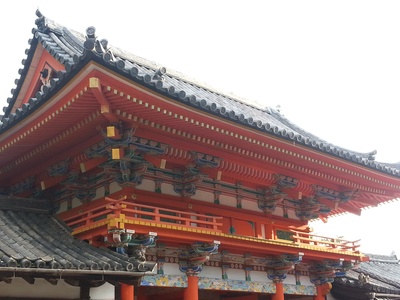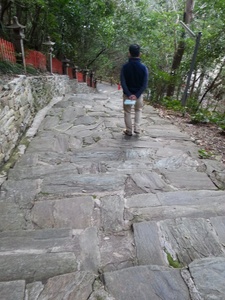纪州 东照宫 (和歌山市和歌浦西 邮编641-0051 电话073 444 0808)
“There are many attractions in the Wakaura,of which the best one is the Gongen”.The sight that eulogizered in this ballad is the Toshogu.The Gongen has been the most famous spot of Wakaura ever since the ancient time and it still has an endless stream of pilgrims until now. the Toshodai Gongen, the Hiyoshi Sanno Gongen, and the Madarashin used to be sacrificed there. The title Tosho dai Gongen,which hold the faith of curing illnesses and realizing dreams, was given to the Physician Buddha as a Japanese God.This version is based on the legend that Ieyasu Tokugawa was the reincarnation of Buddha In 1645, the Toshodai Gongen was changed to Toshogu by the order of royals.
Toshogu was built as the main fortress by Yorinobu Tokugawa,the founder of the Kishu Vassal, in 1621.It was about 400 years ago when the chieftain took charge of the commander himself ,appointed Naoji Ando(Taito) as well as Mitumasa Hikosaka(Kyukyoe) to be the projector and letted person whose position is above samurai to transport the rockworks.Such method was an imitation of Yorimoto Minamotono who built the Turuoka Hachimangu.
Tenkai,the master and monk,led about sixty monks and priests from Edo to take part in the fast in the name of Tendai Shinto.Suketane,The Nakamikado Dainagon and Hirobashi,the prime minister,were demoted to the local as the Imperial messenger .Thus,Tenkai became the first Betsuto.The remedy had been given to the base during the annual sacrifice for fifty yearsafter that.And the convention that color remedy is given every ten or fifteen years still exists nowadays,keeping the Toshogu the same appearance as the original one.
The structure of the sanctuary adopted the architectural form of Gongenzukuri,which is also called Ishinomazukuri.It is the typical important architectural cultural heritage of Momoyama era in the early Edo times.The exquisite craft-work of paint,the colorful workmanlike sculpture and the gorgeous drawing of Tosa makes it live up to the title of The sunlight of Kansai.The sculpture of Sajingoro is rareand the red-painting of tower gate is unique in the world.
As the important cultural treasure,Toshogu is also famous for the material for clothing and other seventeen secret deposits, except for countless weapons,pottery,paintings and others treasures. The six cells both inside and outside of Ungaiin, Tenyo temple,Wakayama was once regarded as the Betsuto temple in the vast land of 25 Tyo around Reikihohattyo and Miyayama.It was ranked NO.1 in the world then.In that very moment,as the south pass of the city,it was in the strategic status. Besides,it could also take the place of mental practice to unite the thinking in peaceful times.
Being worldwide famous, Toshogu is the mixture of the creativity and harmony of the sanctuary which owns the clear water and green plants. It inspires people to look back on the history, to face up to the traditional homesickness and the home of their soul.
Regarding the sacrifice, the quite famous one is the Mikoshidogyosai,which is called Wakamatsuri in folks. Inherited since the built of Toshogu, it is a precious folkways sacrifice for its traditional arts of Kiikuni.According to the convention, Wakamatsuri is held every May,making the hole Wakayama in the deep atmosphere of the ritual.





